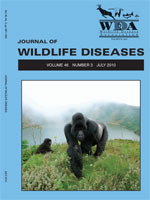We investigated the effect of haloperidol and azaperone in drive-net captured Southern chamois (Rupicapra pyrenaica). Both tranquilizers have been successfully used in a wide range of wild species for reducing postcapture stress response. During 2005, 39 free-ranging chamois were captured, randomly injected intramuscularly with haloperidol (0.29±0.12 mg/kg; n=24), azaperone (1.1±0.82 mg/kg; n=6), or saline (0.5 ml; n=9), and restrained for 3 hr. Heart rate was higher in the treated chamois; erythrocyte parameters and total protein concentration decreased over time owing to splenic sequestration, hemodilution, vasodilation, and reflex tachycardia. Creatinine, sodium, and chloride remained stable only in the haloperidol-treated group, suggesting an improvement in renal perfusion. Nevertheless, the azaperone-treated chamois displayed higher body temperature, and both treated groups had higher serum muscular enzymes than the control group, suggesting higher muscle stress. These results lead us not to recommend the use of these tranquilizers—especially azaperone—as first-choice neuroleptics in chamois.
How to translate text using browser tools
1 July 2010
Haloperidol and Azaperone in Drive-net Captured Southern Chamois (Rupicapra pyrenaica)
G. Mentaberre,
J. R. López-Olvera,
E. Casas-Díaz,
I. Marco,
S. Lavín
ACCESS THE FULL ARTICLE

Journal of Wildlife Diseases
Vol. 46 • No. 3
July 2010
Vol. 46 • No. 3
July 2010
Acute stress
azaperone
chamois
drive-net capture
haloperidol




